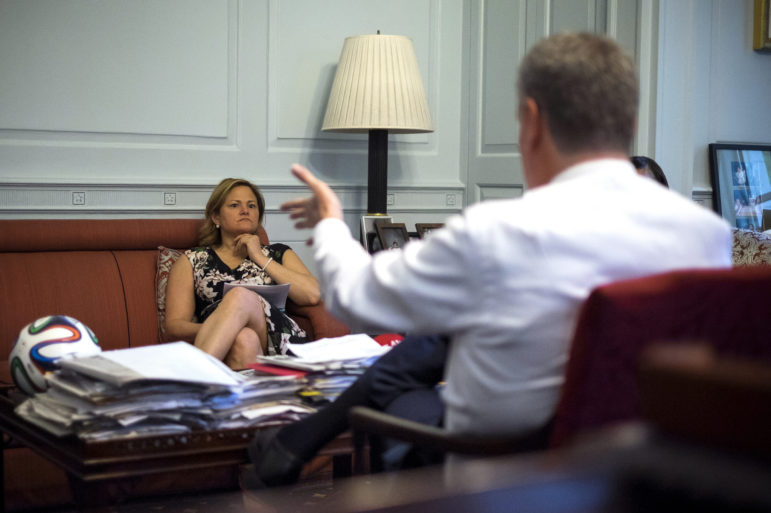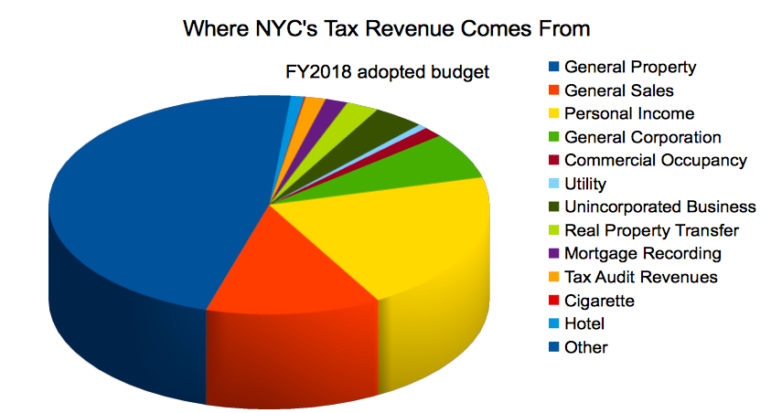
Ed Reed/Mayoral Photography Office.
Mayor de Blasio and Speaker Melissa Mark-Viverito discussing the FY2017 budget. The speaker attempted to move toward property tax reform, but the project stalled. The mayor has said he will take it up in his final term if he is re-elected.
There are people who deny, in the face of mounting scientific evidence, that climate change is something society must address. There are folks who deny any connection between mass-casualty gun attacks and the laxity of most states’ gun laws.
Almost no one, however, denies that New York City’s property tax system is profoundly flawed.
That consensus has not made it any easier to change the system, though. Council Speaker Melissa Mark-Viverito convened a commission to explore ways to do so in early 2014, but it was dead by early 2016.
Since then, however, the pressure to act has mounted. A broad coalition of real-estate groups and advocacy organizations banded together this summer to sue over the racial impact of property-tax unfairness.
In response, Mayor de Blasio has said he will tackle the problem—if he is re-elected—in his second term. “We’re going to put together a process to reform our property tax system. It will be a very complicated process; it’ll probably take several years,” he told WNYC’s Brian Lehrer Show in July. “But it will result in laws that I will propose at both the city and state level to create more fairness and consistency in the property tax system and much more transparency.”

The most important tax
That suggests property-tax reform will join homeless-shelter siting, neighborhood rezonings and closing Rikers as the heftiest policy lifts of a second de Blasio term, if the mayor is re-elected in November.
His chief opponent, Republican nominee Assemblywoman Nicole Malliotakis of Staten Island, has also brought up the possibility of property tax reform, but has focused on imposing a 2 percent cap on annual increases in tax assessment.
New York City’s budget this year totals $85.2 billion. About $57 billion of that is paid for by taxes; the rest is covered by fees, federal and state funding and other smaller revenue sources. About $26 billion of the city’s tax haul comes from property taxes, more than twice as much as comes from any other tax. The city’s personal income tax, for instance, brings in about $11 billion.
Property taxes are calculated by applying a tax rate to a portion of the estimated market value of each property. Last year, more than a million properties paid the property tax—although roughly half of that were only partially taxable because of some tax break attached to the parcel. Another 45,000 properties (churches, universities, et cetera) were fully exempt.
But not all properties are treated in the same way.
A touch of class(es)
New York City properties are divided into four classes. Class 1 includes one- to three-family homes. Class 2 covers all other residential properties. Class 3 is for utilities and Class 4 for commercial real estate.
Disparities pop up because the city assesses Class 1 properties at 6 percent of market value and all other properties at 45 percent. So this means that homeowners pay a lower share of the property tax bill than they otherwise might. According to the Independent Budget Office, Class 1 properties comprise 30 percent of the city’s total market value but only pay 14 percent of the property taxes.
Another problem is that the city bases market value for coops and condos on the income earned by nearby rental buildings, a method that tends to undervalue the coops and condos, meaning they pay a lower share of the tax levy than they otherwise might.
There are disparities, too, even among buildings in the same tax class. These occur because the law caps how much a property’s assessment can rise year to year. It does this to protect homeowners from big jumps in their tax bills. But it means that owners of property in snazzy neighborhoods where real-estate has risen sharply in value pay less in taxes (proportionately, and sometimes in absolute terms) than people who own lower-value property in areas of the city where growth has been slower.
This creates individual episodes of inequality among homeowners as well as huge geographic disparities between neighborhoods that are hot and neighborhoods that are not.
Not an easy fix
As important as the property tax is to New York City’s budget, the city is fortunate that other taxes (especially the personal income tax, which is progressive) are part of the mix. Other New York State municipalities rely primarily on the property tax, and therefore are even more vulnerable to the inherent problems of that form of taxation.
Still, New York City couldn’t afford to get less revenue out of its property tax; if anything, it could use more. That makes the task of property-tax reform daunting because the city can’t just cut taxes to correct the inefficiencies. It has to instead tinker with the mechanisms of the tax, which will inevitably create winners and losers.
It’s not a binary issue, either. The looming discussion of property tax reform could pit coop owners against rental landlords, both of those groups against homeowners, and homeowners in one type of neighborhood against those in another.
Plus, you can’t separate the tax discussion from other policy goals. Does the city want to incentivize homeownership? Does it want to help neighborhood retail? As is the case with the federal tax code, the property-tax system reflects some of these policy priorities, and they are bound to be part of any debate over changing it.
Add to the mix the continuing criticism of tax breaks like 421-a, which reduce the effective burden of property taxes, and you have a tangle of policy issues to unwind. (As attractively simple as a 2 percent cap might seem, it is not without its own downsides.)
The policy puzzle would be intimidating even if the city could tackle it on its own. But it can’t.
While the city sets the property tax rates for each class, most other aspects of the system are controlled by state law. That means property tax reform will require the mayor and City Council, local members of the State Senate and Assembly and upstate reps who have nothing to do with our neighborhoods, as well as the governor—some of whom will face voters in 2018 and 2020, the rest not until 2021—to reach some kind of rough consensus on reform.
New York City’s Tax Mix
FY2018 adopted budget
| Tax | Expected FY18 Revenue (millions) | Share of tax revenue |
| General Property | $25,812 | 45.37% |
| General Sales | $7,319 | 12.87% |
| Personal Income | $11,841 | 20.82% |
| General Corporation | $3,890 | 6.84% |
| Commercial Occupancy | $848 | 1.49% |
| Utility | $382 | 0.67% |
| Unincorporated Business | $2,137 | 3.76% |
| Real Property Transfer | $1,364 | 2.40% |
| Mortgage Recording | $934 | 1.64% |
| Tax Audit Revenues | $850 | 1.49% |
| Cigarette | $42 | 0.07% |
| Hotel | $570 | 1.00% |
| Other | $898 | 1.58% |









One thought on “Policy Brief: NYC’s Looming Task of Property Tax Reform”
This is being sold to NYC’s renters as a way to lower their rents by lowering the property tax rate on apartment buildings. Keep dreaming.
The relatively low property tax rate on class-1 properties help keep the home-owning middle-class in the city. Raise class-1 taxes to suburban rates and there is no longer an incentive for the middle-class to remain in the city. Suburban schools are better than NYC schools and the streets are cleaner out there too.
This is nothing more than a war on class-1 property owners. A war which will be led by Bill deBlasio who publicly stated in New York Magazine that he doesn’t believe in private property rights – http://nymag.com/daily/intelligencer/2017/09/bill-de-blasio-in-conversation.html